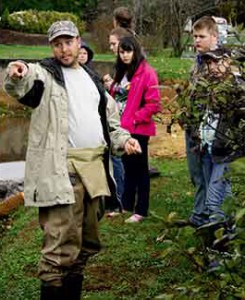Written by Ryan Hanchett of The Franklin Press

Crawford Branch meanders through Franklin, both above and below ground, with little fanfare.
The stream’s most visible point is the tenth of a mile that runs down the middle of Memorial Park, where a group of agriculture students from Franklin High School gained familiarity with the stream on Wednesday as part of a live-staking project administered by Mainspring Conservation Trust citizen science program manager Jason Meador.
The students learned a lesson in biology as they cut and pruned silky dogwood branches and placed them in the ground to help prevent further erosion of the stream bank. The live stakes will grow into silky dogwood trees that will provide shade to the stream.
“The actual bank of the stream is being reshaped and matting is being laid down to promote a more gradual slope,” Meador said. “One of the reasons for that is because every time the stream rises and falls it erodes the bank and it begins to cave in.”
According to Meador, creating a more gradual stream bank will allow rising water to spread out and decrease the velocity at which it rushes into the areas where the bank turns.
The live-staking project is part of a larger Crawford Branch restoration effort that is being coordinated by Mainspring. In October 2014, Duke Energy awarded a grant of $20,000 to kick off the restoration. The Town of Franklin got on board and provided both funds and manpower to the project.
“We have done stream bank restorations before, but this one is unique because of all of the groups that have come together to make it happen,” Mainspring Conservation Trust Associate Director Ben Laseter said. “Duke Energy, the Town of Franklin, Macon County Soil and Water Conservation District, the U.S. Fish and Wildlife Service and the Tennessee Valley Authority have all contributed to the work that is being done on this site.”
In order to use heavy equipment in the waters of Crawford Branch, Mainspring had to obtain a permit from the U.S. Army Corps of Engineers. That permit was approved in October and work began on Monday.
According to Laseter, the first phase of the project will take about a month to complete and a second phase will likely begin in the spring of 2016.
“We are going to create a natural riffle by placing some rocks in two spots in Memorial Park,” Laseter said. “What that will do is promote consistent water depth and it will also slow down the flow as water moves toward the culvert under Palmer Street.”
Once the stream bank restoration is complete there will be increased vegetation along the bank as well as some kind of fence to indicate a clear mowing line for town maintenance crews. There will also be educational signage placed in Memorial Park to indicate the importance of the stream bank restoration project as well as the importance of Crawford Branch to the Little Tennessee River watershed.

